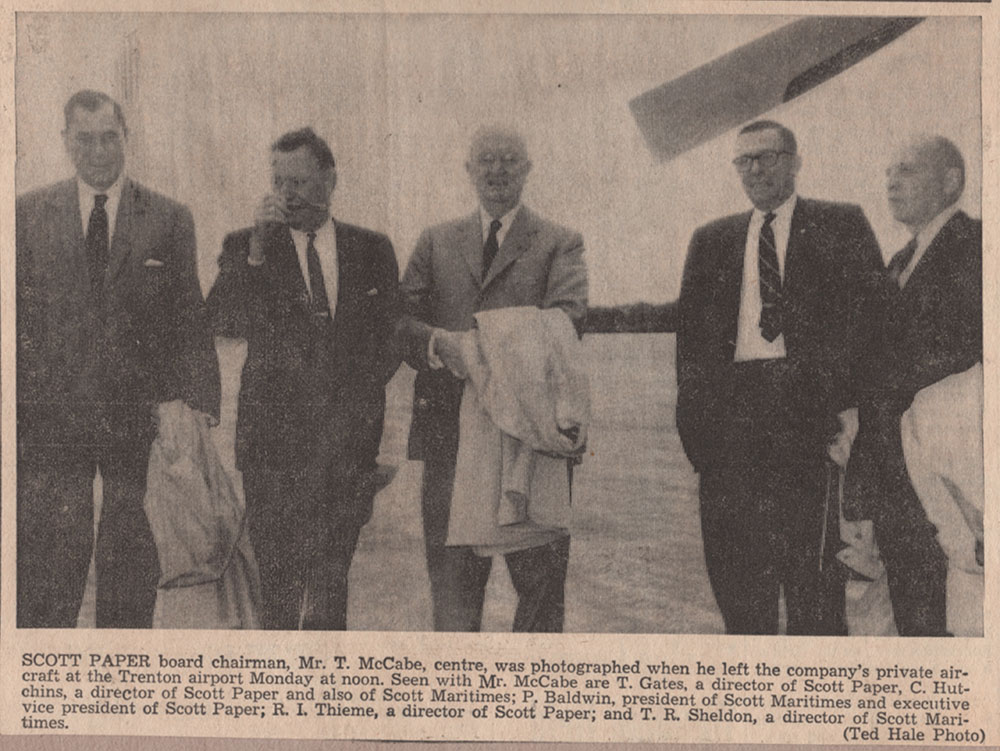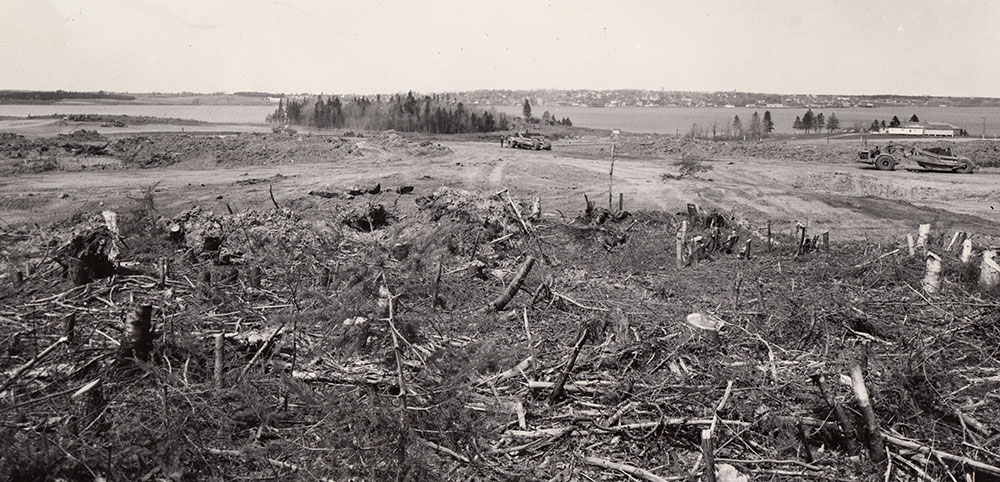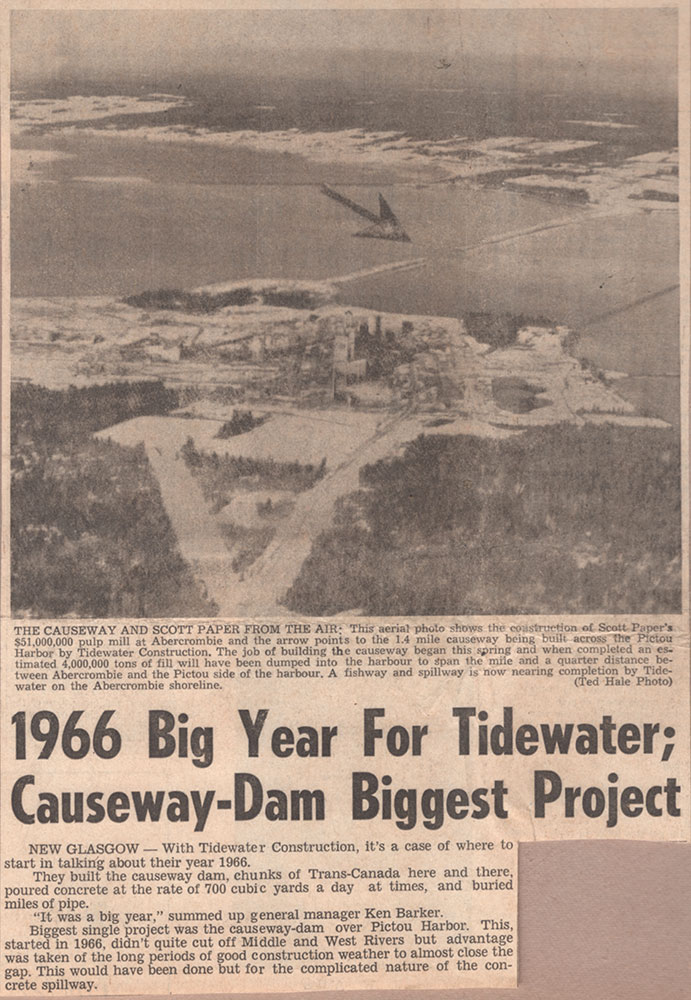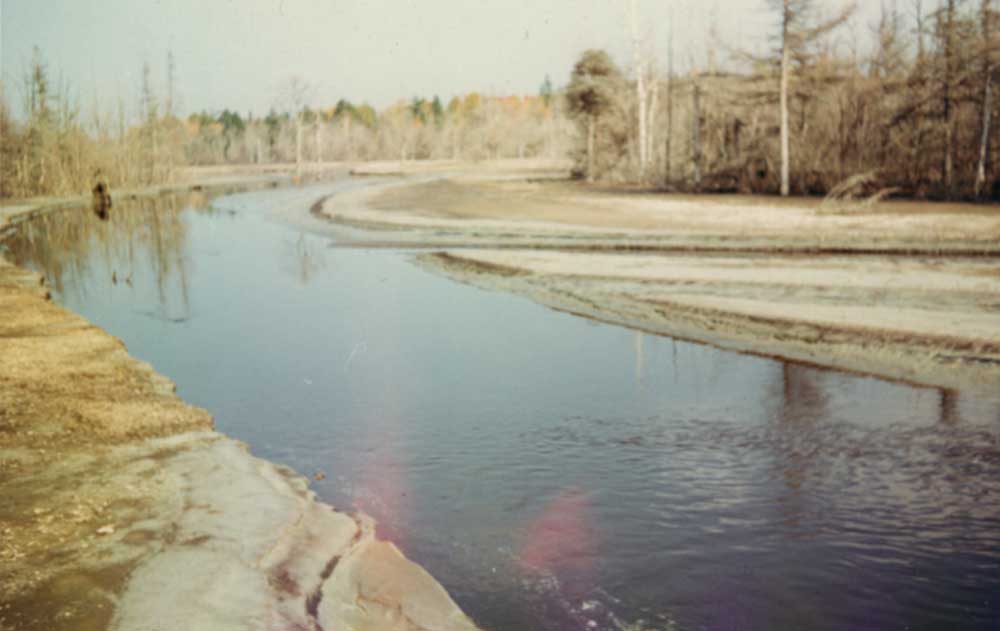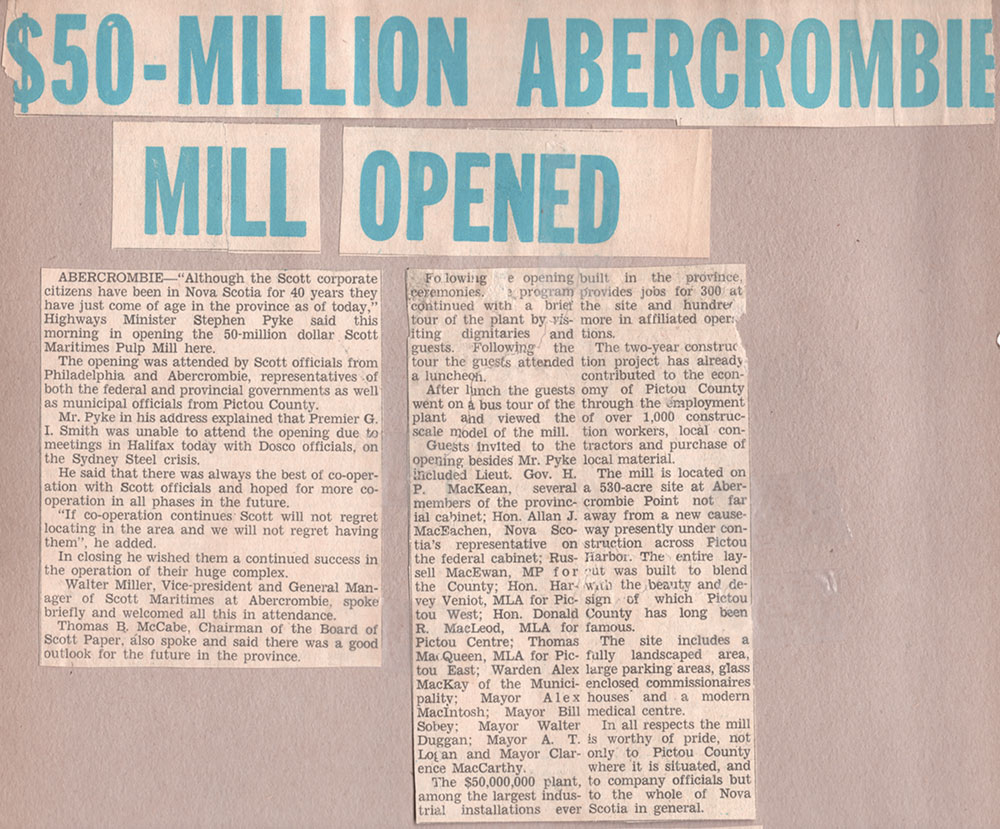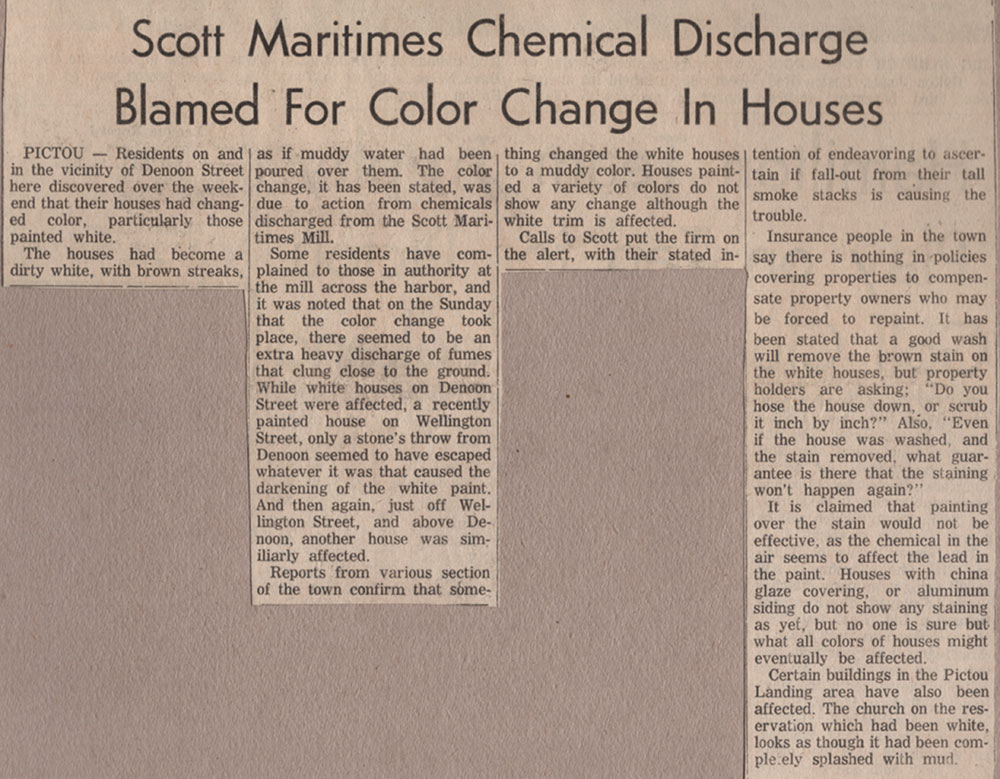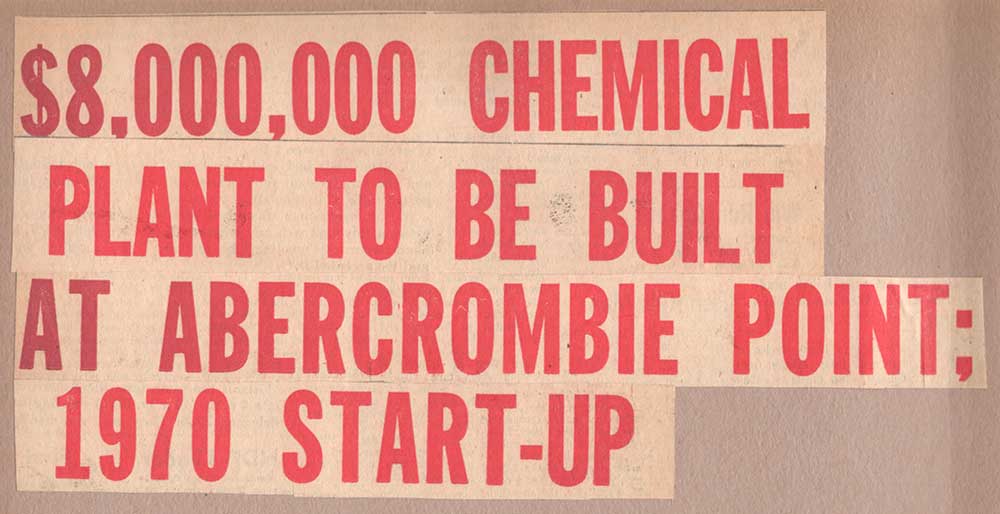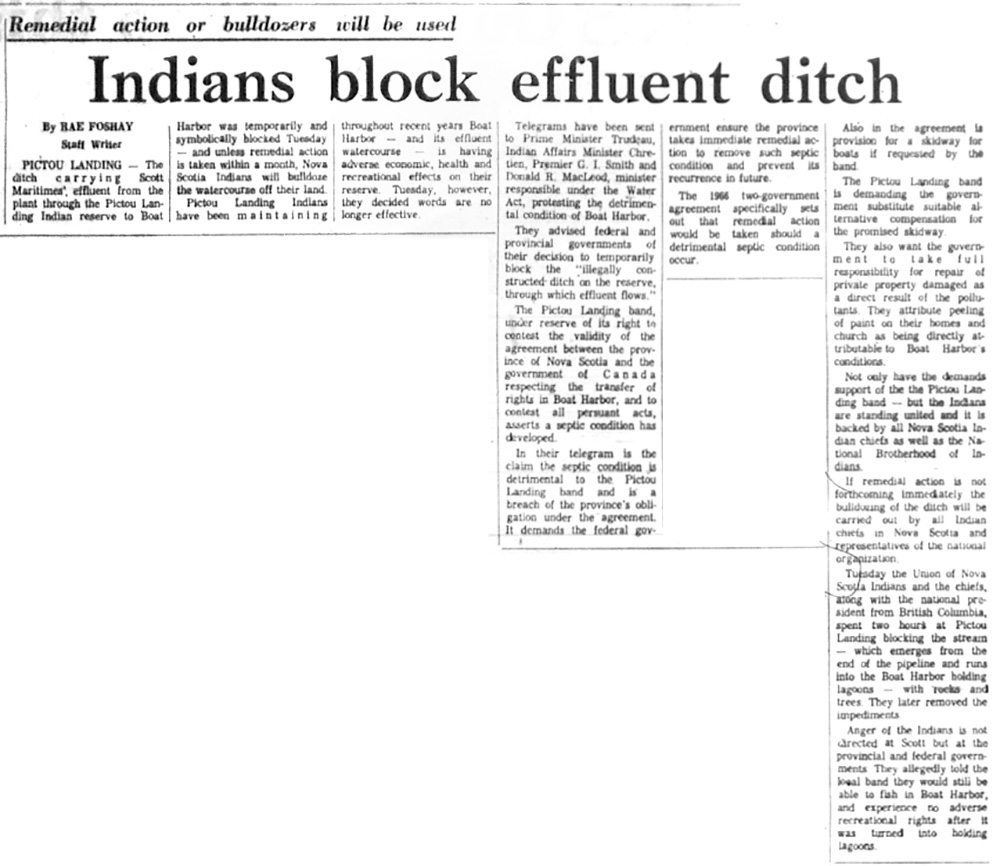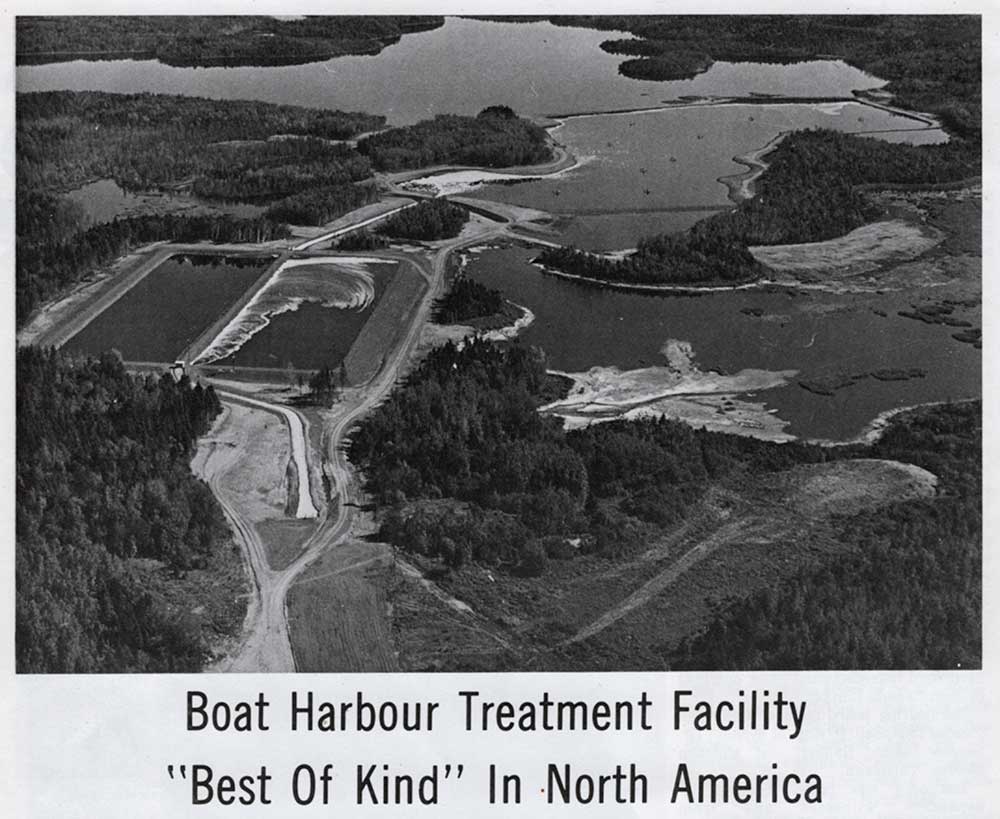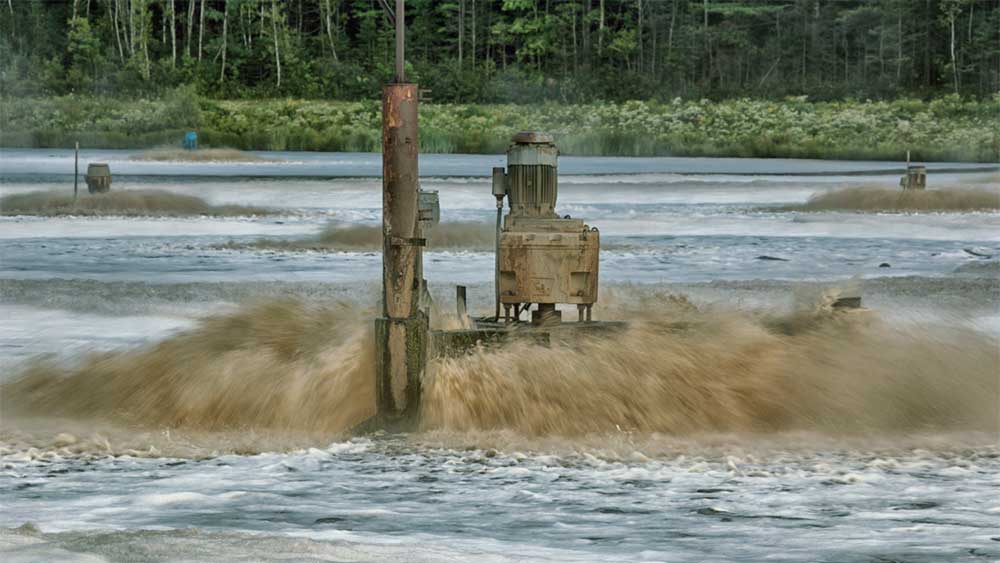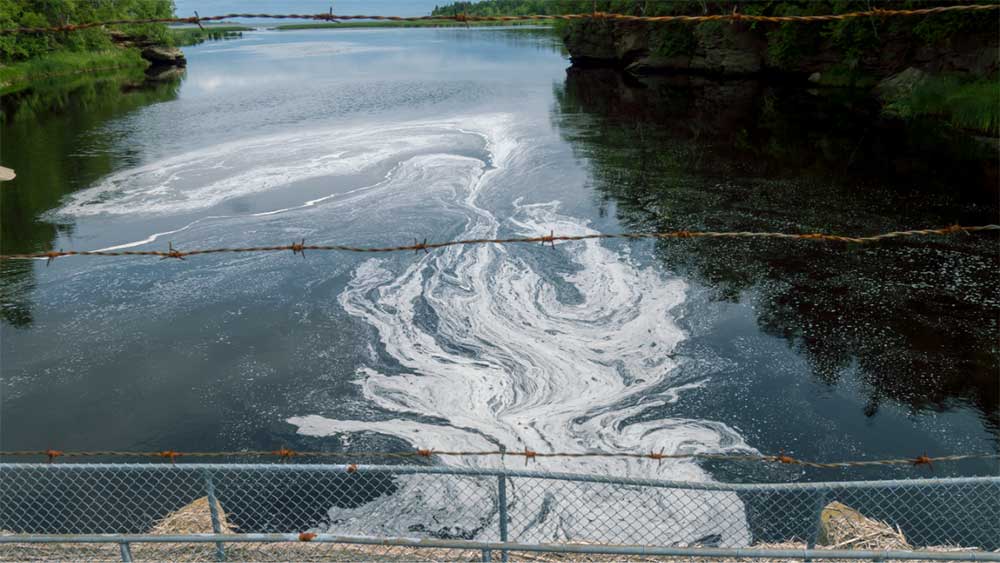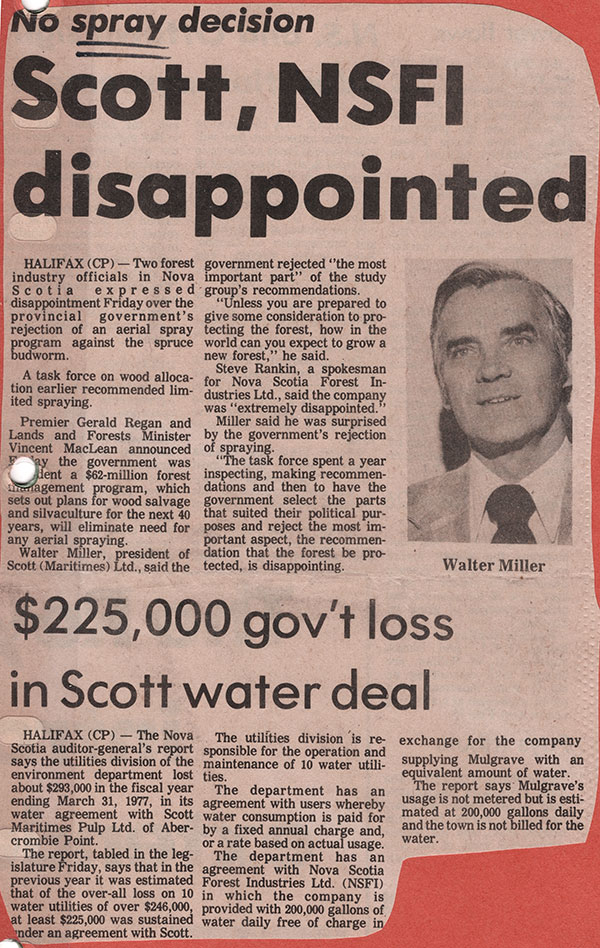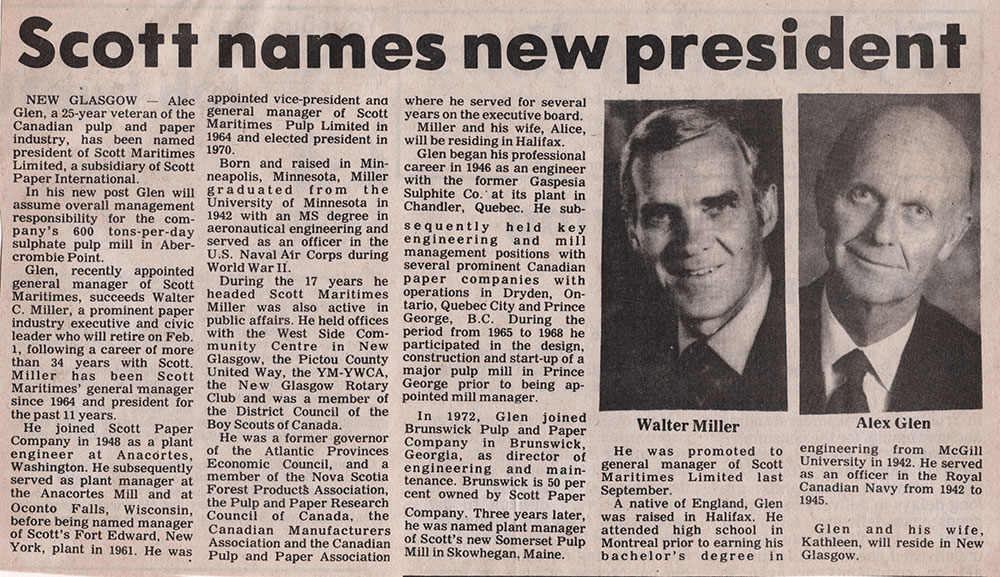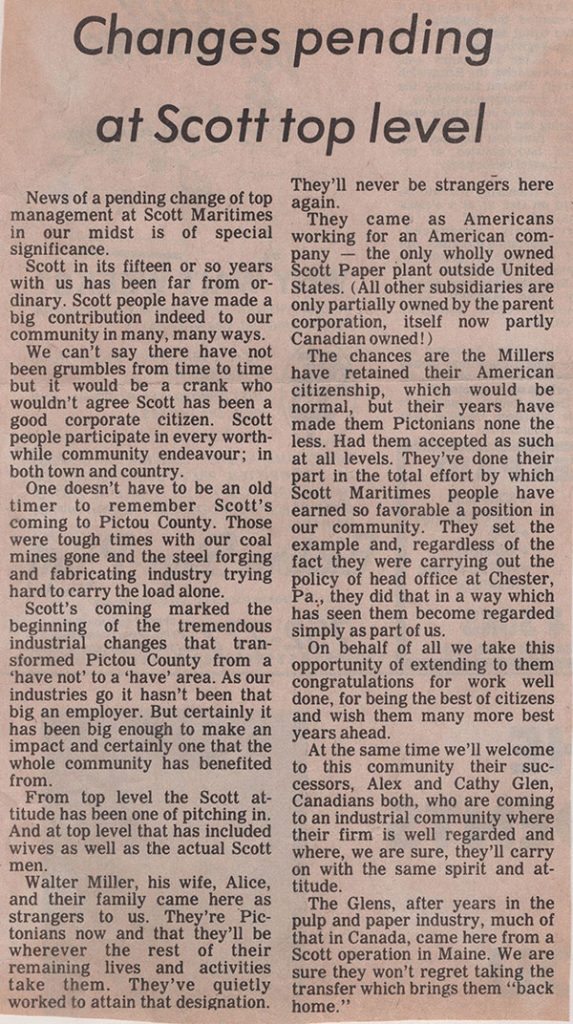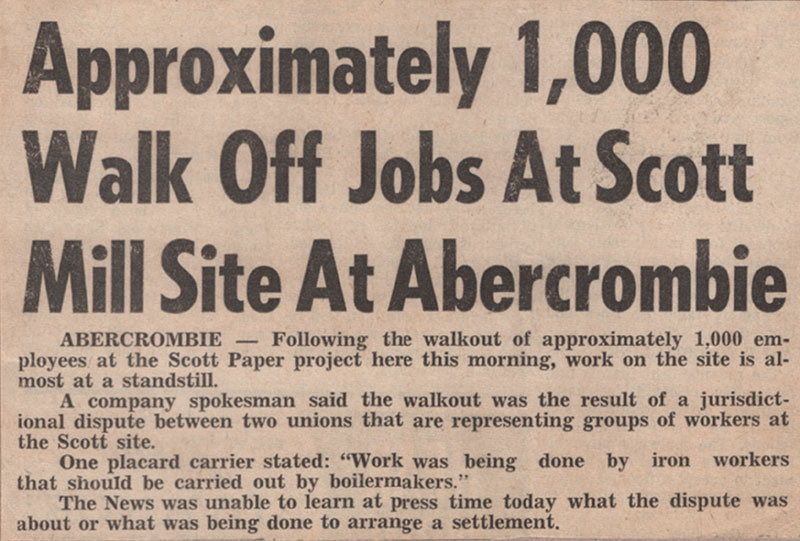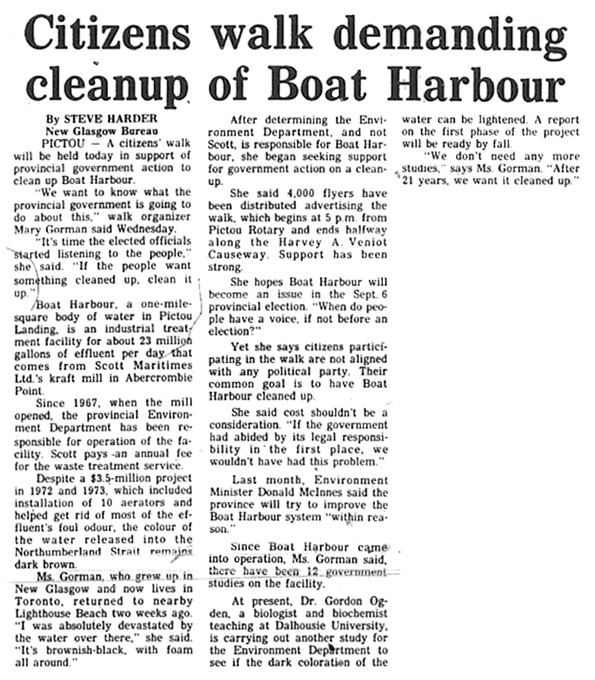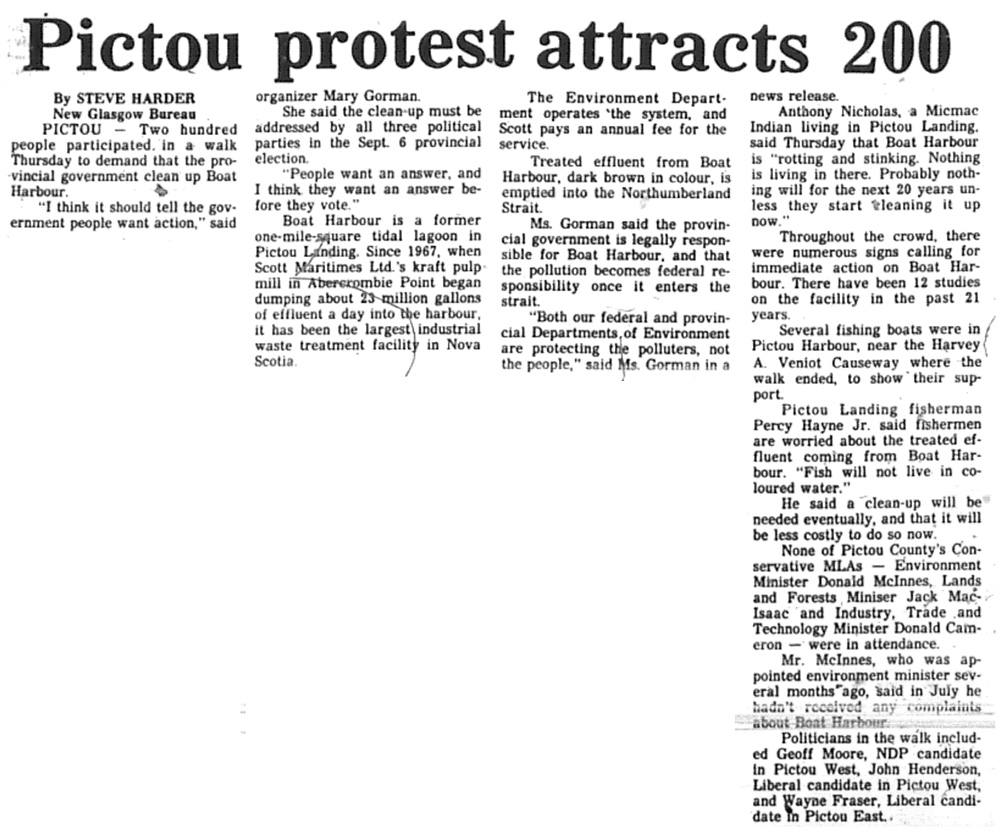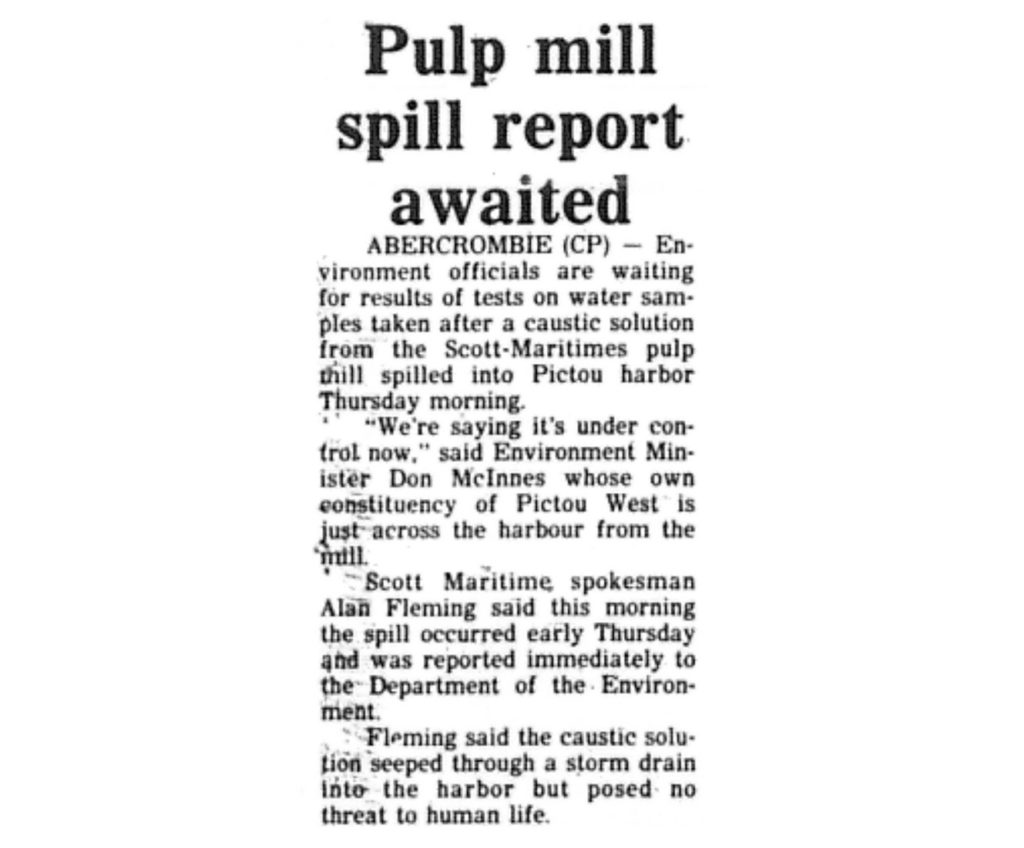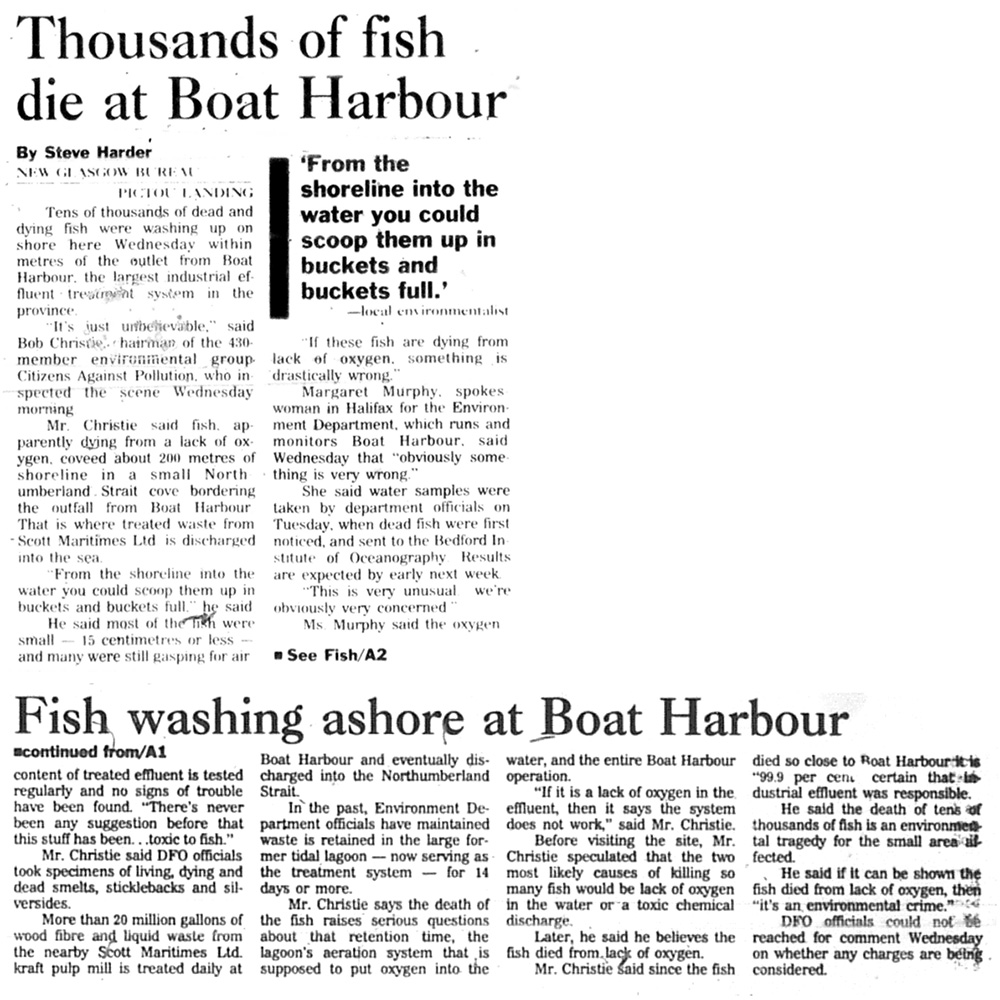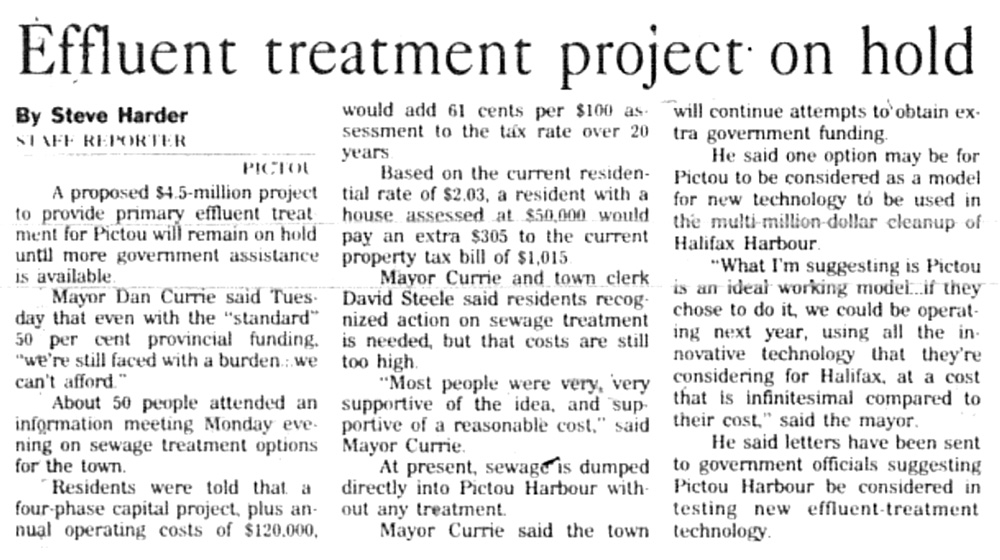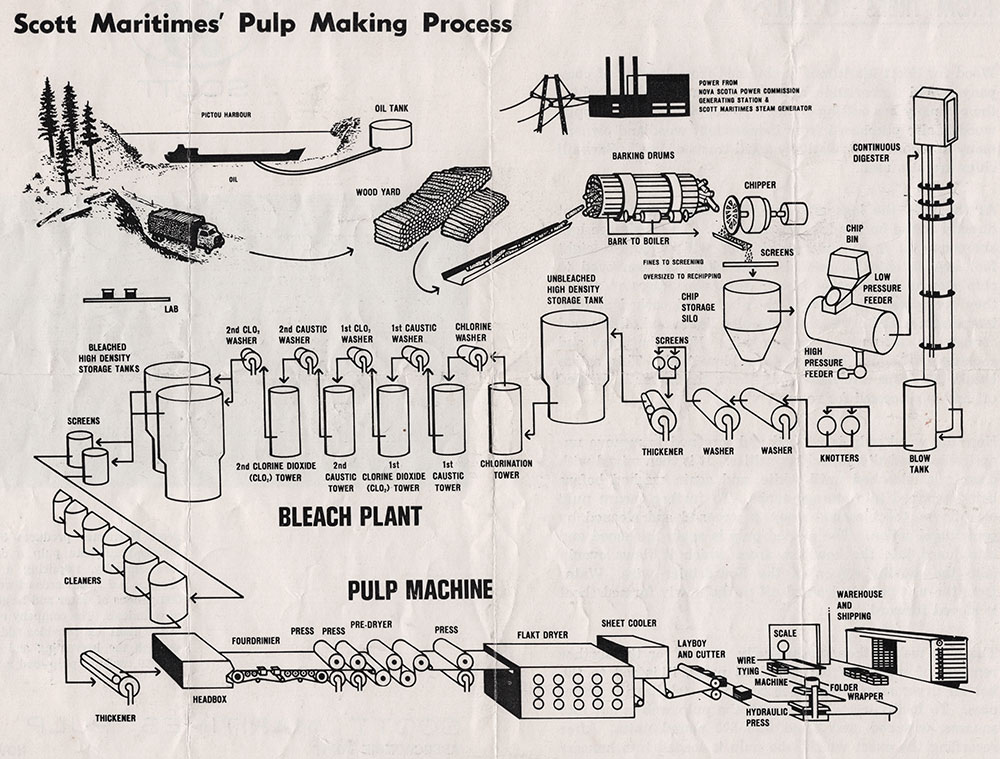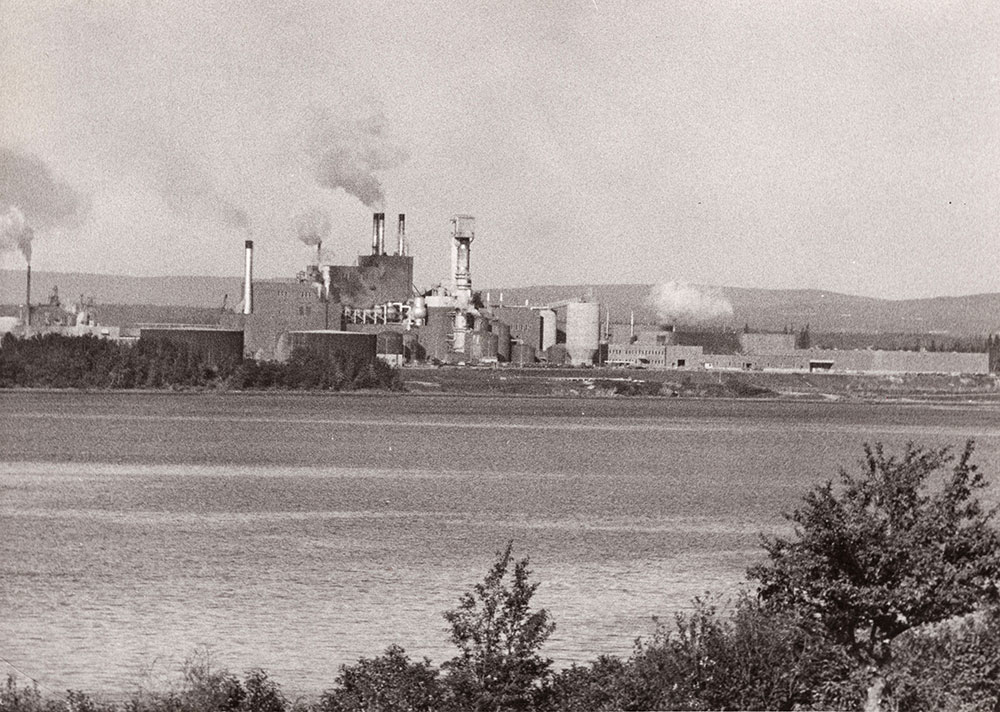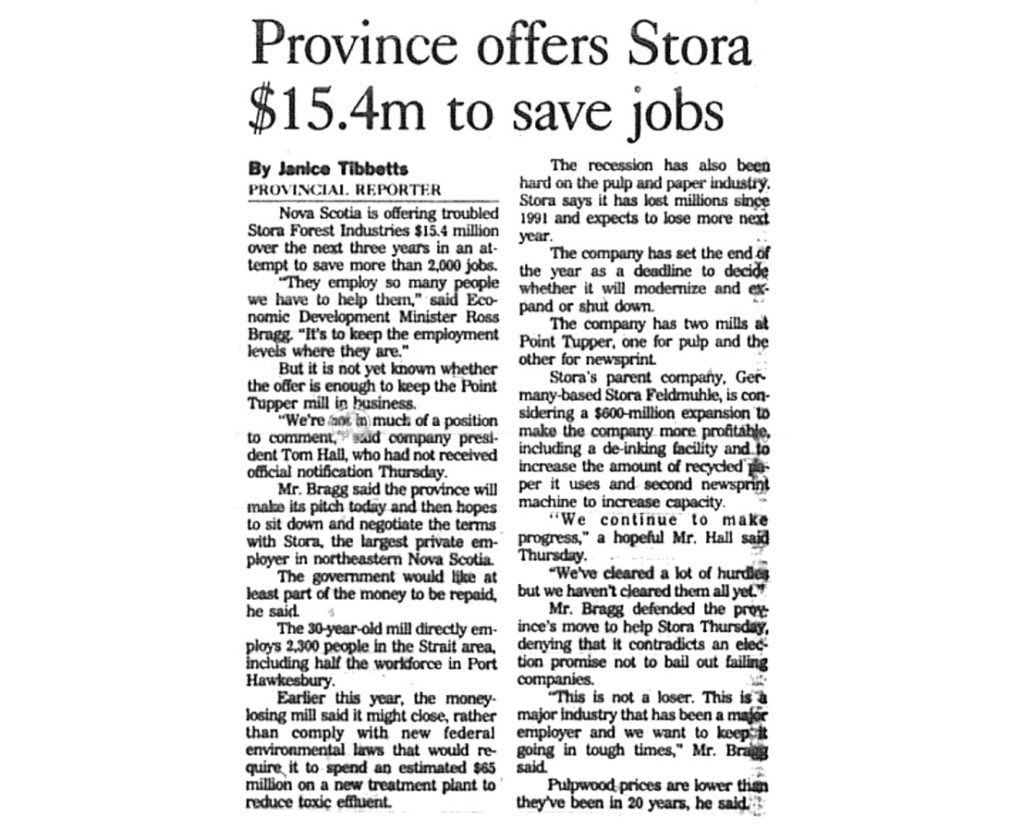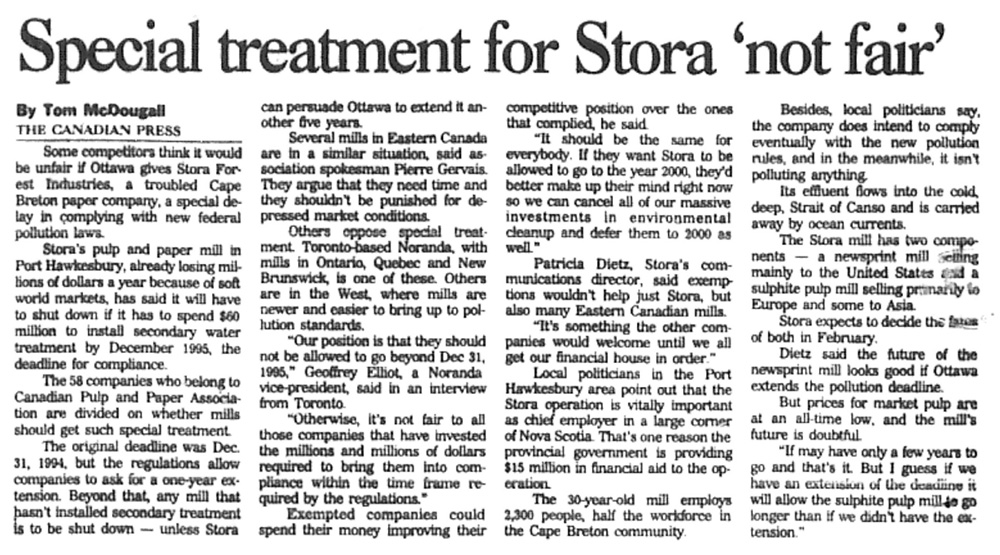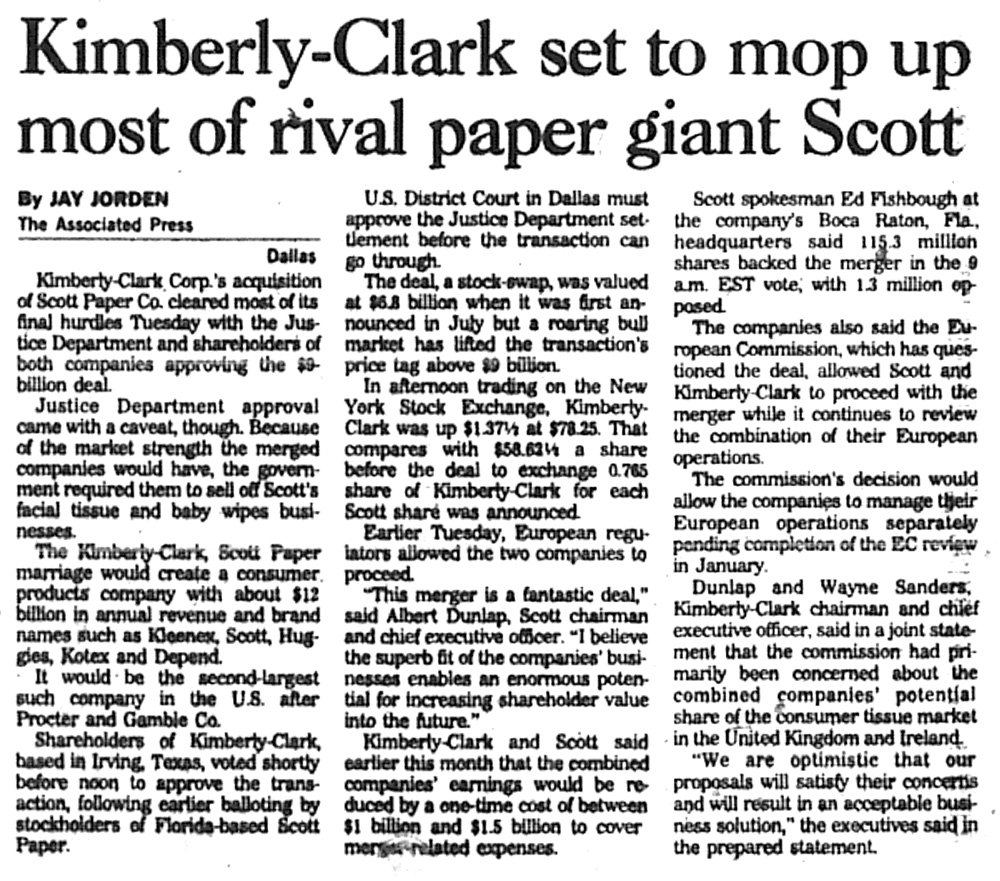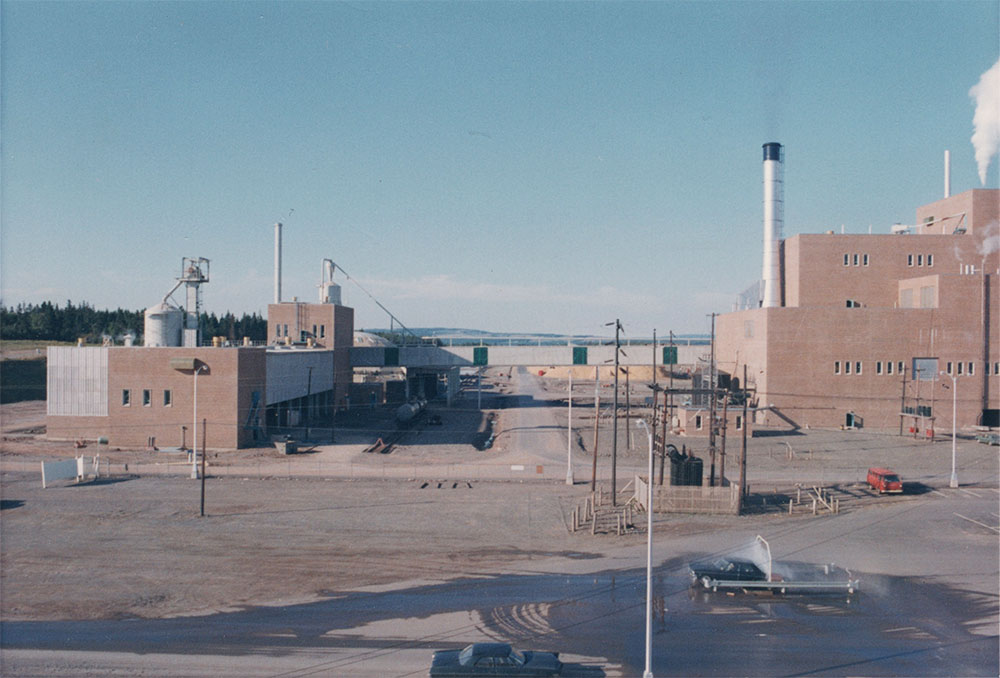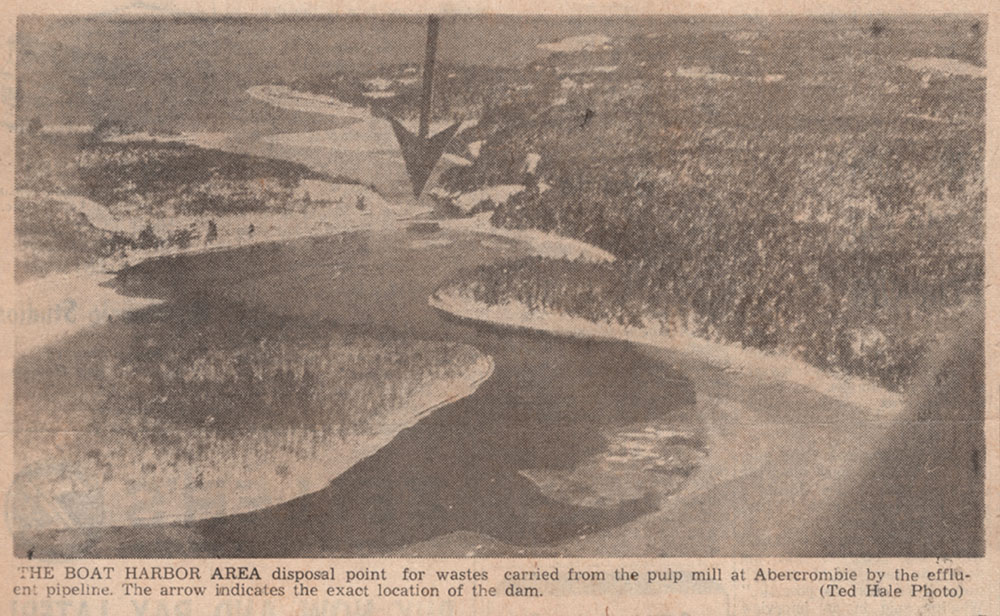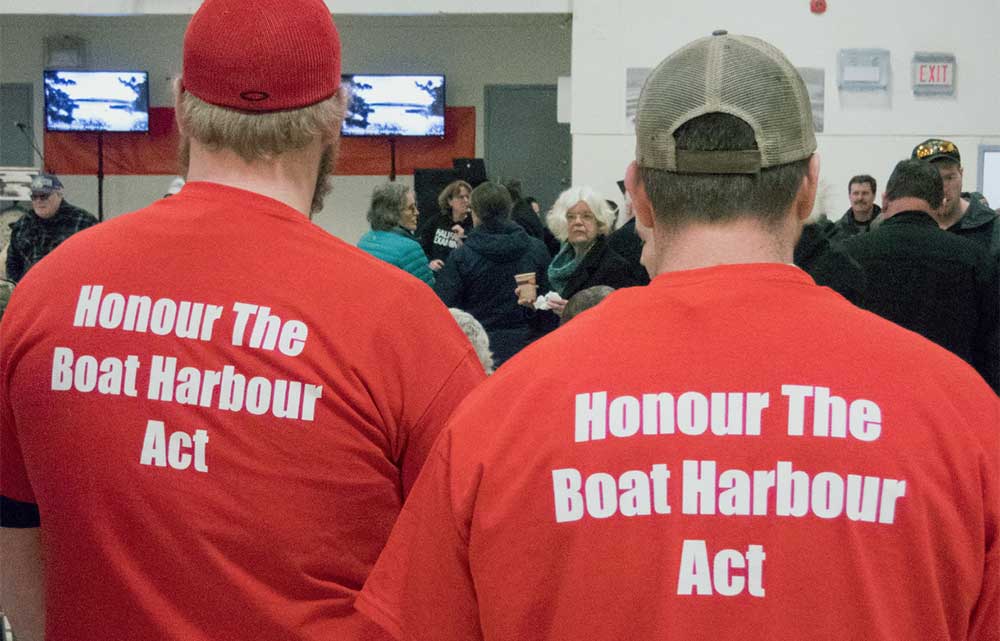A timeline of Pictou County’s history with the mill…

Royal Assent
NS government passes Scott Maritimes Limited Agreement Act, and the day the Act receives royal assent, it cancels the Small Tree Conservation Act, which protects immature stands of trees.
The province also agrees to provide the mill with more than 100 million litres of fresh water daily by damming two rivers, and to lease 93,000 hectares of Crown timberland. This is in addition to the more than 400,000 hectares of woodland Scott already owns in the province.
A False Premise
In October, officials from Nova Scotia Water Authority invite Pictou Landing First Nation (PLFN) Chief and Band Councillor to New Brunswick, pretending to show them a functioning waste treatment system similar to the one proposed for the PLFN tidal estuary, A’se’k, or Boat Harbour, where the Water Authority wishes to send effluent from the proposed pulp mill. On this false premise, they convince the PLFN to transfer property rights for the province of Nova Scotia, without authorization under the Indian Act. Band receives $65,000. (Photo: Fergie MacKay)
Chlor-alkali Plant Opened
Despite opposition from citizens concerned about mercury pollution, Canso Chemicals Limited – owned jointly by Scott Maritimes, N.S. Pulp Ltd. in Port Hawkesbury, NS, and Canadian Industries Ltd. – opens a chlor-alkali plant adjacent to the Pictou pulp mill to supply it with chlorine for the pulping process.
September 23: Indians Block Effluent Ditch
Pictou Landing First Nation ceremonially close the stream carrying mill effluent through Reserve lands to Boat Harbour, protesting the pollution there and contesting the validity of the transfer of their rights for Boat Harbour to the province.
Source: The Chronicle Herald, Courtesy of Nova Scotia Archives (microfilm #5991)
Modifications
After years of protest by PLFN and non-Indigenous fishermen and other concerned citizens – including unionized workers at the mill, teachers, religious leaders, medical doctors – the treatment facility is modified with new settling ponds and aeration, and a dam is built to control outflow from the Boat Harbour lagoon to the Strait. (Photos: Gerry Farrell)
October: Mercury Losses
Canadian Press reports that Canso Chemicals lost five tons of mercury in 1975, and that unaccounted mercury losses have averaged several tons per year since federal reporting began in 1972.
November: New Equipment
Nova Scotia government of Liberal Premier Gerald Regan approves $2.5 million for equipment to reduce particulate matter emissions from the pulp mill.
Lawsuit Filed
PLFN chief files lawsuit against federal government for failing to protect First Nation interests when province deviously acquired rights to Boat Harbour.
August 19: Pictou Protest Attracts 200
In the lead-up to a provincial election, about 200 people representing a newly formed group called Citizens Against Pollution protest the mill’s pollution in Boat Harbour with a blockade on the causeway and fishing boats beside it in Pictou Harbour.
Source: The Chronicle Herald, Courtesy of Nova Scotia Archives (microfilm #6322)
36-day Blockade
Growing opposition to herbicide spraying to promote growth of pulp species for the Pictou mill culminates in a 36-day blockade near Tatamagouche, Nova Scotia, by the members of the “Boycott Scott Committee.” On September 10, three protesters are arrested.
Health Risks Studied
Springtime “Funeral”
In early spring, members of the Boycott Scott Committee, the North Shore Environmental Web, and the “Green Web” group mobilize more than 60 people for a mock “funeral” for woodlands in Colchester County, which have been clearcut for the pulp mill.
October 11: Thousands of Fish Die at Boat Harbour
Tens of thousands of fish die at the outfall of Boat Harbour into the Northumberland Strait. The federal justice department later overrules Environment Canada, and decides not to charge the province of Nova Scotia, which owns the treatment facility, for the fish-kill.
Source: The Chronicle Herald, Courtesy of Nova Scotia Archives (microfilm #6375)
November: Treatment Facility Recommended
A study by H.A. Simons and funded by the federal and provincial governments and Scott Maritimes, is released. It recommends the design and construction of a $74-million treatment facility, upgrading settling and aeration basins, and then piping the treated effluent two kilometres into the Northumberland Strait, bypassing Boat Harbour.
Promises Made
Nova Scotia government under PC Premier Donald Cameron promises to close Boat Harbour to mill effluent when its agreement with Scott Maritimes ends in 1995.
More Promises Made
Provincial PC government again promises to close the Boat Harbour treatment facility at the end of 1995.
Two Years to Comply
Federal government gives Nova Scotia two years, until December 31, 1995, to comply with new federal regulations on pulp mill effluent and to resolve Boat Harbour ownership issue, as provincial ownership expires that year.
Out of Court Settlement
Federal government settles out of court, paying Pictou Landing First Nation $35 million to avoid a lawsuit mounted by the Band because Ottawa failed to protect them when the rights for Boat Harbour were signed over to the province.
1,900 Names
Northumberland Fishermen’s Association sends petition with 1,900 names to federal Minister of Fisheries Brian Tobin saying the proposal to pipe effluent into the Strait threatens the fishery. In Parliament, Tobin says that the proposed treatment facility would require a full environmental assessment, and that this has not been done.
December 13: Kimberly Clark set to mop up rival Paper Giant Scott
December: Agreements Signed
The province of Nova Scotia under Liberal Premier John Savage signs three agreements with Kimberly-Clark. One provides total indemnity to the company for the remediation of Boat Harbour and any future reconfiguration of the mill for effluent treatment. Another extends the mill’s use of Boat Harbour for mill effluent until 2005, with a pledge to restore the lagoon for $5-6 million after it is closed. Another hands responsibility for the effluent treatment facility to the company, with a grant for $1.75 million to upgrade aeration capacity.
Conditions Proposed
PLFN says it will not oppose extending the operation of the treatment facility to 2030 on condition that Kimberly-Clark will build a pipeline to bypass Boat Harbour in 2005, when the lagoon is to be closed, cleaned up and restored as a tidal estuary by the provincial government.
October: Leaking Effluent Discovered
The owner of a property where the effluent pipeline under the East River comes ashore at Indian Cross Point, Pictou Landing and runs underground to Boat Harbour, discovers that the underground pipe has been leaking effluent to the surface.
Lease Extended
The Progressive Conservative government of NS Premier John Hamm extends the lease for the mill’s use of the Boat Harbour treatment facility until December 31, 2020, without consulting PLFN or waiting until the existing lease ends in 2005, at which point a bypass pipeline is supposed to be built.
May: Three Leaks
Three leaks are discovered in the effluent pipeline running under the mouth of the East River, between Abercrombie Point and Boat Harbour.
Precondition Broken
Consultants for Kimberly-Clark say bypass pipeline will cause eutrophication as effluent will be pushed back into Boat Harbour from the outlet into the Strait, so it will not be built, although it was a precondition for PLFN to agree to the lease extension. Nevertheless, the lease extension remains in place.
February 25: Neenah Paper
Kimberly-Clark announces that its Canadian pulp operations are to be spun off to a separate entity called Neenah Paper, so the owner of the mill in Pictou County is now Neenah Paper.
Deadline Passes
No pipeline has been built and Boat Harbour does not close as promised. Kimberly-Clark and the Nova Scotia government under PC Premier John Hamm ask PLFN for an extension of the use of Boat Harbour until 2008.
Extension for Closure
PLFN agrees to an extension until 2008, provided the bypass pipeline is built by the end of that year.
June: Land Holdings Sold
Neenah Paper sells more than half of its land holdings in NS – more than 200,000 hectares – to the New Hampshire investment firm, Wagner Forest Management Ltd, which divides the land between two separate corporate entities, Atlantic Star Forestry and Nova Star Forestry, one with woodlands to be clearcut to feed the pulp mill (Wagner signs an agreement with Neenah to this effect) and the other to hold properties to be sold off as cottage lots.
Mill Sold
Neenah Paper sells the mill to Northern Resources, owned by the New York private equity firm Blue Wolf and the Connecticut holding company, Atlas Holdings, which form an affiliate company called Northern Pulp Nova Scotia Limited.
Deadline Missed
Provincial government under PC Premier Rodney MacDonald and Northern Pulp ask PLFN for an extension on the use of Boat Harbour past 2008. PLFN refuses. Northern Pulp misses the deadline to complete a bypass pipe and stop using Boat Harbour for its effluent.
November: Leak Discovered
The owner of property near Indian Cross Point where the effluent pipeline comes ashore from under the East River and runs underground towards Boat Harbour, discovers that there is a leak and that effluent is visible on the surface of the River. This is the second time the same property owner has discovered leaks in the effluent pipeline while walking his dog.
Loan
PC government of Premier Rodney MacDonald loans Northern Pulp $15 million from the Industrial Expansion Fund.
Negotiations
PLFN repudiates 2001 agreement to extension of use of Boat Harbour to 2030 because the bypass pipeline has not been built. The province launches negotiations with PLFN for continued use of the Boat Harbour treatment facility. In June, PC government is defeated and replaced by NDP government under Premier Darrell Dexter, which discontinues negotiations.
Calls for Epidemiological Study
New citizens’ group, Pictou County Watershed Coalition, reiterates calls to the provincial government to undertake an epidemiological study to determine the effects of industrial contaminants in the air and water, including Boat Harbour and the area around its outlet on the health of residents of Pictou County.
30-Year Loan
The NDP government of Premier Darrell Dexter gives Northern Pulp a 30-year $75 million loan to purchase 192,226 ha of land from Neenah Paper, and then pays $16.5 million more to the company to buy 22,258 ha of that same land from Northern Pulp, gifting the company nearly $7 million in the deal.
August: New Chair
Former PC Premier John Hamm becomes chair of the board of Northern Pulp Nova Scotia Corporation, the umbrella company of eight companies registered in Nova Scotia.
September: Lawsuit Filed
In September, the PLFN Band files a lawsuit against the province, Northern Pulp, and all its former owners to have the facility shut down. (The case is dormant but still live today; neither the province nor the mill’s previous owners have filed a defense.)
January: $28.1 million Grant
Peter MacKay, federal Minister of Defence in Prime Minister Stephen Harper’s Conservative government, announces $28.1 million grant to Northern Pulp from Natural Resources Canada and the Green Transformation Fund for reducing odour emissions, upgrading boiler and increasing use of renewable energy.
April: Northern Pulp Sold
Blue Wolf and Atlas Holdings sell Northern Pulp Nova Scotia Corporation and all its Nova Scotia holdings to Paper Excellence, part of the giant corporate holdings of the Widjaja family of Indonesia.
January: Offer Made
The NDP government of Darrell Dexter writes to Northern Pulp CEO to offer 125,000 green tonnes of fibre a year from the former Bowater lands in southern Nova Scotia, which the Crown purchased for $111.7 million with widespread public support provided that the public was fully consulted over their use. This offer to Northern Pulp is made before any consultation takes place, and the terms of the offer are not made public.
January: 10-Year Loan
The NDP government gives Northern Pulp a 10-year $14.7 million loan, another for $2.5 million (no interest, and forgivable with conditions). Some of this money finances a new chipping facility at Northern Pulp, which leads to the closure of two independent chipping facilities that together had employed 88 people.
April: Expiration
Northern Pulp’s Industrial Approval expires, but is extended for one year.
Clean The Mill
Clean The Mill, a new citizen group, is formed to push for an end to the mill’s air and water pollution. In July, a few members of that group launch new Facebook page, Clean Up the Pictou County Pulp Mill, to create awareness and share information about life near the pulp mill and its waste treatment facility at Boat Harbour. (Photo: Gerry Farrell)
October 1: 4-Year Loan
Just 21 days before Dexter’s NDP government is voted out of office and replaced by the Liberals under Stephen McNeil, the NDP government gives Northern Pulp a 4-year $3.6 million loan.
November: Two Directives
Nova Scotia Environment issues two directives to Northern Pulp following exceedances, one for total reduced sulfur emissions and one for particulate matter emissions that were found to be 78% higher than permitted by the Industrial Approval.
April: Another Extension
Northern Pulp’s Industrial Approval is extended again, this time until January 2015.
June: Pipeline Break
There is major effluent pipeline break at Indian Cross Point, and 47 million litres of effluent flood a Mi’kmaq burial ground. The mill shuts down and PLFN peacefully blockades the site. In exchange for a pledge from the Liberal government that it will legislate a closing date for Boat Harbour, PLFN agrees to lift the blockade so the mill can restart.
September: Concert Organized
Following a summer with some days of extreme air pollution in Pictou before a new precipitator is installed, in September a “Clean The Mill” concert is organized on the waterfront by the Clean The Mill group and another calling itself Clean Pictou Air Group of Businesses. The concert attracts about 3,000 people.
January: New Industrial Approval Released
Nova Scotia Environment releases a new Industrial Approval that emphasizes environmental improvements in three areas – air emissions, water usage, and effluent. Northern Pulp contests these provisions and government agrees to review them. Requests for still stricter provisions by PLFN and Clean The Mill are denied.
March: Boat Harbour Act Passed
The Boat Harbour Act is passed by all three political parties, setting January 31, 2020 as the closing date for the Boat Harbour treatment facility.
June: “Incentive”
Northern Pulp receives a $900,000 “incentive” it has “earned” from the provincial government.
July: Major Concessions
Nova Scotia environment minister makes major concessions to Northern Pulp in a revised Industrial Approval. Northern Pulp is still dissatisfied. It goes to the Supreme Court of Nova Scotia to appeal the Industrial Approval.
September: Emissions Reduced
Tests show particulate matter emissions have been reduced by a new precipitator, but the province issues a directive for Northern Pulp to reduce emissions from its power boiler.
January: Guilty
Northern Pulp pleads guilty to breaking sub-section 40(6) of the Fisheries Act – “unlawfully depositing or permitting deposit of a deleterious substance, namely pulp and paper effluent, in water frequented by fish” – during the 2014 pipeline break.
February: Giving in to Demands
The provincial minister of environment – the third in just one year – issues the new Industrial Approval, giving in to Northern Pulp demands. The company withdraws its appeal in the Supreme Court.
May: Fined
Northern Pulp is fined $225,000 for breaking the Fisheries Act in 2014, of which $75,000 are to go to the Mi’kmaw Conservation Group, $75,000 to the Pictou County Rivers Association, and $75,000 to the Pictou Landing First Nation.
Engineers Hired
Northern Pulp and the province hire engineers to design a new treatment facility for the mill, 4.5 years after the province agreed to close Boat Harbour, and 2.5 years after the Boat Harbour Act becomes law.
July: 45-Day Assessment
The Nova Scotia government determines that a 45-day Class I environmental assessment is sufficient for Northern Pulp’s new effluent treatment facility, rather than a more stringent and longer Class II environmental assessment.
November and December: Meetings
Northern Pulp meets with fishermen and PLFN to reveal the plans to build an Activated Sludge Treatment (AST) facility beside the mill and to pipe the effluent under Pictou Harbour into the Northumberland Strait. This is the same AST plan first proposed by consultants in 2000 and 2010. A request from PLFN that tertiary treatment proposed by consultants in 2011 is rejected by the province, which appears to be responsible for the costs of the new facility because of previous agreements it signed with the mill (1995 and 2002). Reaction to Northern Pulp’s proposal is largely negative.
December: Bookstore Boycott
Northern Pulp orchestrates a letter-writing campaign among employees and former employees to threaten boycotts of all Chapters / Indigo / Coles bookstores across Canada if the author of a new book, The Mill – Fifty Years of Pulp and Protest, is permitted to sign copies at a bookstore in New Glasgow, Pictou County. The book signing is cancelled.
“No Pipe” campaign
The Northumberland Fishermen’s Association, together with fishermen’s groups in Prince Edward Island and New Brunswick, launch a “No Pipe” campaign in opposition to the Northern Pulp plans to pipe treated effluent into the fishing grounds in the Northumberland Strait.
Push For Assessments
A new citizens’ group, Friends of the Northumberland Strait, is formed and works with fishermen’s groups to push for a Class II provincial environmental assessment and also a federal environmental assessment.
Early July: New Pipe Route
Northern Pulp announces that the plan to pipe effluent under Pictou Harbour is not feasible, and changes the proposed route for the effluent pipe. The plan is to pipe the effluent about 15 km across the causeway, and along the edge of Highway 106, and out into the Northumberland Strait at Caribou Harbour.
July 6: Land-And-Sea Rally
PLFN, the Northumberland Fishermen’s Association, and Friends of the Northumberland Strait link up with other citizen groups to organize a land-and-sea rally on the Pictou waterfront and in Pictou Harbour to call on the government and the mill to find an alternative to putting mill effluent into the Strait. And estimated 1,000 people from three Maritime provinces gather on land, hundreds more come in fishing and pleasure boats, and several Mi’kmaq chiefs are present to support the “No Pipe” rally. (Photos: Robert Bean)
January 31: Countdown Begins
PLFN organizes an event in the local school gymnasium to celebrate the beginning of the 365-day countdown to the closure of Boat Harbour, with roughly 600 people in attendance.
On the same day, Northern Pulp organizes a press conference in Halifax. It announces that it has registered its effluent treatment and disposal project with the provincial government, and that it will need an extension on its use of Boat Harbour “in the proximity” of a year past January 31, 2020, the date stipulated for closure by the Boat Harbour Act. The public has 30 days to comment on the project proposal. The province receives 4,423 pages of submissions.
March 29: Focus Report
Nova Scotia’s environment minister announces that Northern Pulp needs to provide the province with a focus report, as there are 19 items missing from its proposal. Paper Excellence Canada CEO renews the company’s calls for the government to extend the legislated closure date for Boat Harbour.
Continued Pressure
Throughout the spring, sawmill operators, forestry operators, as well as UNIFOR that represents pulp mill workers, continue to pressure the government of Premier Stephen McNeil to extend the deadline for the closure of Boat Harbour with letter-writing campaigns, media pieces and also a highway protest by truckers.

